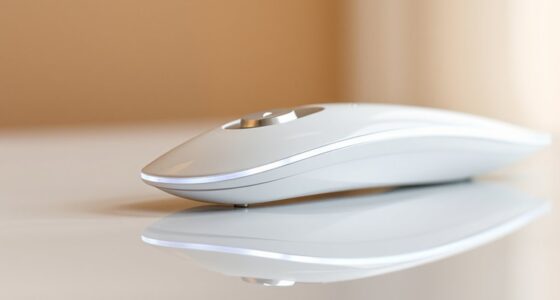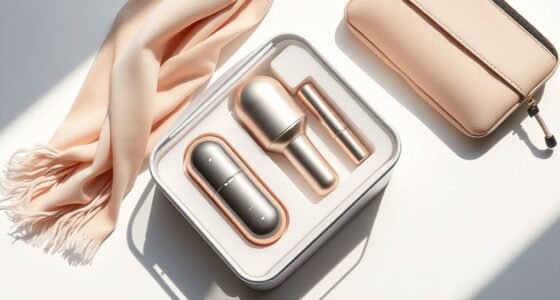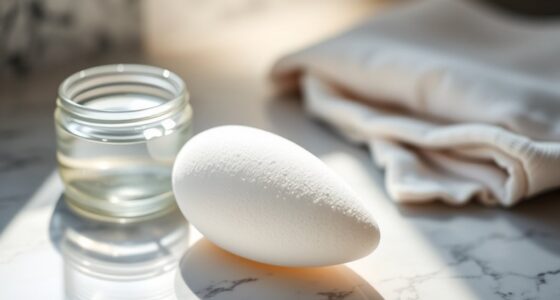If you’re choosing between dermarollers and microneedling pens, consider your budget, skin type, and wanted control. Dermarollers are affordable, simple, and portable, making them great for at-home use, but they offer less precision. Microneedling pens cost more but provide adjustable settings, better control, and potentially safer results, especially for sensitive skin. To understand which option best fits your needs, explore the differences and benefits in more detail.
Key Takeaways
- Dermarollers are affordable, reusable, and simple, while microneedling pens are more expensive but offer adjustable settings and advanced features.
- Dermarollers are portable and suitable for most skin types, including sensitive skin, with proper technique to minimize risks.
- Microneedling pens provide precise control, adjustable needle depths, and are often safer for targeted or deep skin treatments.
- Both tools require proper sterilization; dermarollers need regular cleaning, whereas pens often have sterilizable cartridges.
- Long-term, microneedling pens may deliver more consistent results and better customization for various skin concerns.

When it comes to skin rejuvenation, dermarolling and microneedling pens are popular choices, but understanding their differences can help you choose the right option. One of the first considerations is the cost comparison. Dermarollers are generally more affordable upfront, often costing between $10 and $50 for a good quality device. They’re reusable, so you can save money over time, but you’ll need to replace or sterilize them regularly to prevent infections. Microneedling pens tend to be more expensive, with prices ranging from $100 to several hundred dollars, depending on the brand and features. However, they are often portable and come with adjustable settings, which can be beneficial if you plan to do treatments frequently. The initial investment in a microneedling pen is higher, but over the long term, it might be more cost-effective if you prefer a device that offers consistent results with minimal additional purchases. Additionally, microneedling pens often include adjustable needle depths, making them suitable for targeting different skin concerns more precisely. Suitability for skin types is another key aspect. Dermarollers work well for most skin types, including sensitive or acne-prone skin, because they offer controlled depth of penetration and are less aggressive than some devices. However, with dermarollers, you need to be cautious about applying too much pressure or using a roller with too many needles, which can cause irritation or damage, especially if your skin is very sensitive. Microneedling pens are versatile and can be adjusted for different skin types and concerns. They often feature variable needle depths, making them suitable for treating deeper scars or wrinkles, and are generally gentler when used correctly. If you have sensitive skin, a microneedling pen with adjustable settings allows you to customize the treatment, reducing the risk of adverse reactions. Conversely, if you have very sensitive or reactive skin, you might want to start with a dermaroller under professional supervision to gauge how your skin responds. Ultimately, your choice should consider how comfortable you feel with each device, your budget, and your skin’s specific needs. Dermarollers are a good entry point if you’re on a budget and want a straightforward, at-home device. Microneedling pens, while pricier, offer advanced features, better control, and are generally safer for a wider range of skin types. Both tools can deliver effective results when used correctly, but understanding their differences ensures you pick the one that fits your skin goals and lifestyle best.
Frequently Asked Questions
Can Dermarollers Be Sanitized Properly for Repeated Use?
Yes, you can sanitize dermarollers properly for repeated use. To guarantee device longevity and prevent infection, clean your dermaroller after each use with isopropyl alcohol or a specialized disinfectant. Rinse thoroughly and let it dry completely before storing. Avoid sharing your device, and replace the dermaroller every few months or when the needles show signs of wear. Proper cleaning is vital for safety and maximum results.
Are Microneedling Pens Suitable for Sensitive Skin Types?
Think of microneedling pens as gentle rain for your skin—perfect for sensitive skin types. They’re designed with adjustable settings, making device compatibility easier, so you can customize the treatment to suit your delicate skin. If you’re cautious about irritation, a microneedling pen offers a controlled, less abrasive experience compared to other tools. Just make certain you choose a device with appropriate needle depth and settings tailored for sensitive skin.
How Long Does It Take to See Results From Each Method?
You’ll typically see visible improvements from dermarolling or microneedling pens within 4 to 6 weeks, but it depends on your treatment frequency and skin concerns. Most people notice smoother, firmer skin after 3 to 6 sessions, with each session spaced about 4 weeks apart. The full effects usually become apparent after about 3 months, with continued improvement as you maintain your treatment routine.
What Are the Safety Concerns With At-Home Dermarolling?
Did you know that improper hygiene practices can lead to infections in up to 10% of at-home dermarolling users? Safety concerns include using unclean devices, which increase bacteria risk, and choosing low-quality dermarollers that may cause skin damage. Always sterilize your device before use, opt for high-quality tools, and follow proper hygiene practices to avoid complications and guarantee safe, effective treatments at home.
Do Professional Treatments Differ Significantly From DIY Devices?
Professional treatments differ markedly from DIY devices because they follow strict professional standards and use calibrated equipment. You get better results and safety because trained practitioners customize treatment depth and technique. DIY devices lack precise calibration, increasing risks of injury or ineffective results. While DIY options are more convenient and affordable, choosing professional treatments guarantees proper device use, safety, and ideal outcomes tailored to your skin’s needs.
Conclusion
Ultimately, whether you choose dermarolling or a microneedling pen depends on your skin goals and comfort level. Think of it like planting a garden—you need to pick the right tools to help your skin flourish. Remember, Rome wasn’t built in a day, so patience and consistency are key. Whichever method you choose, trust that with time and care, your skin will bloom into its best self.









